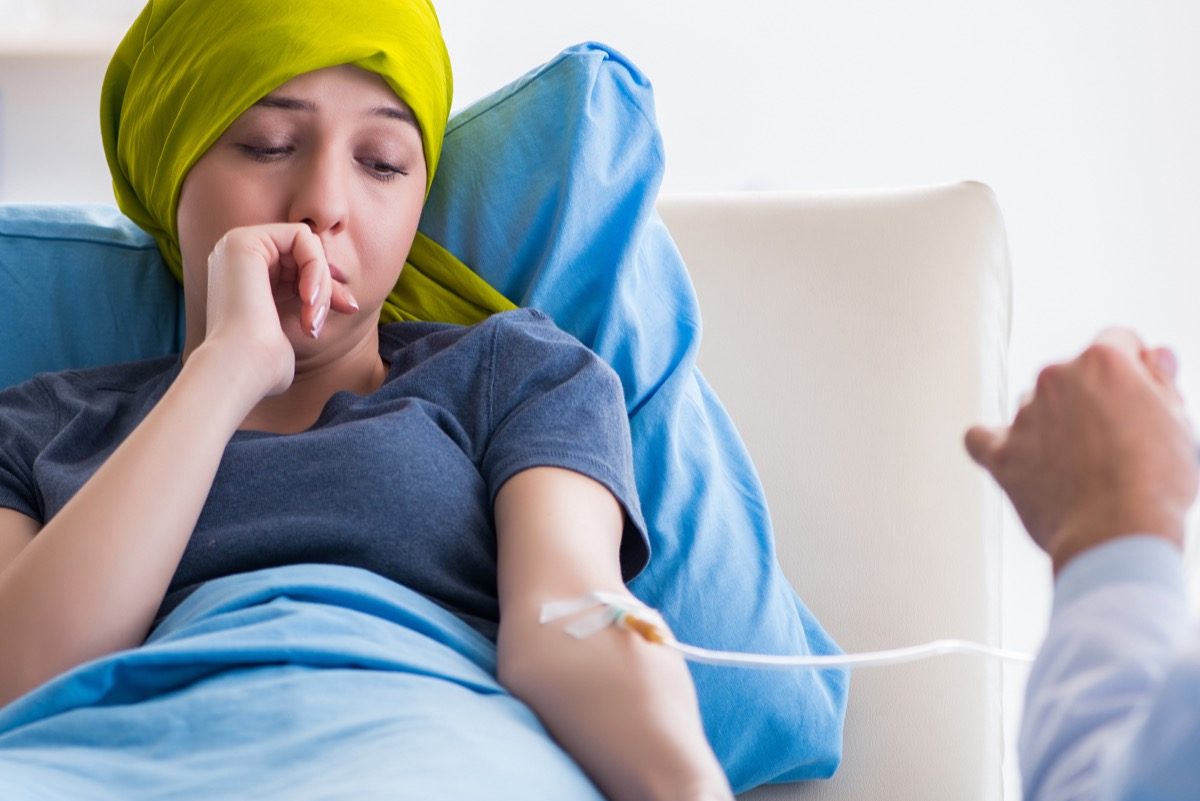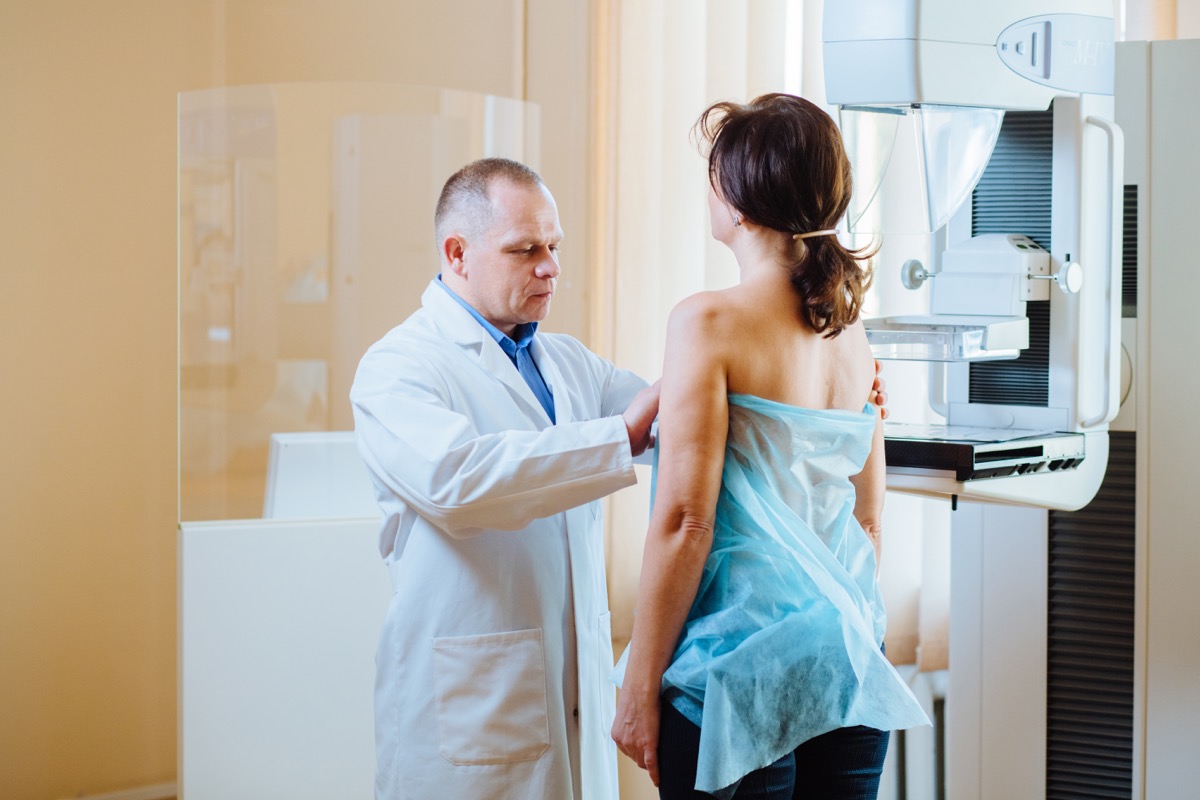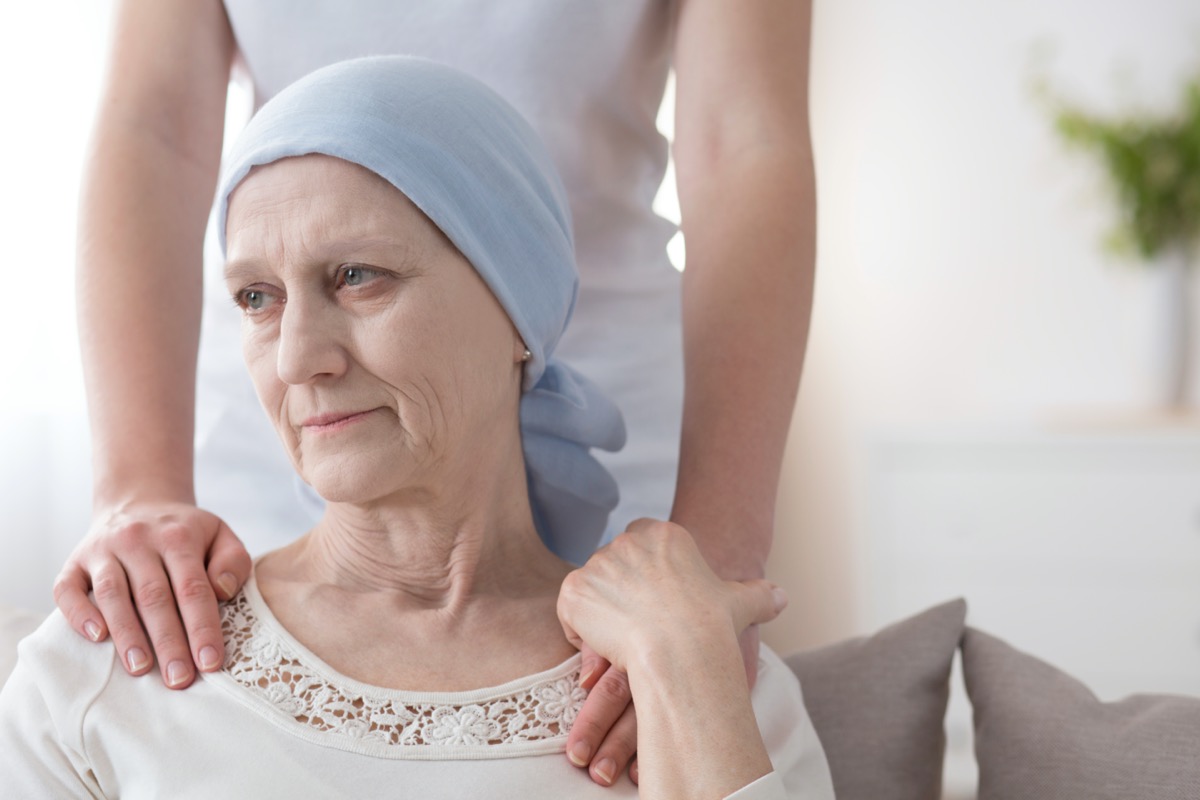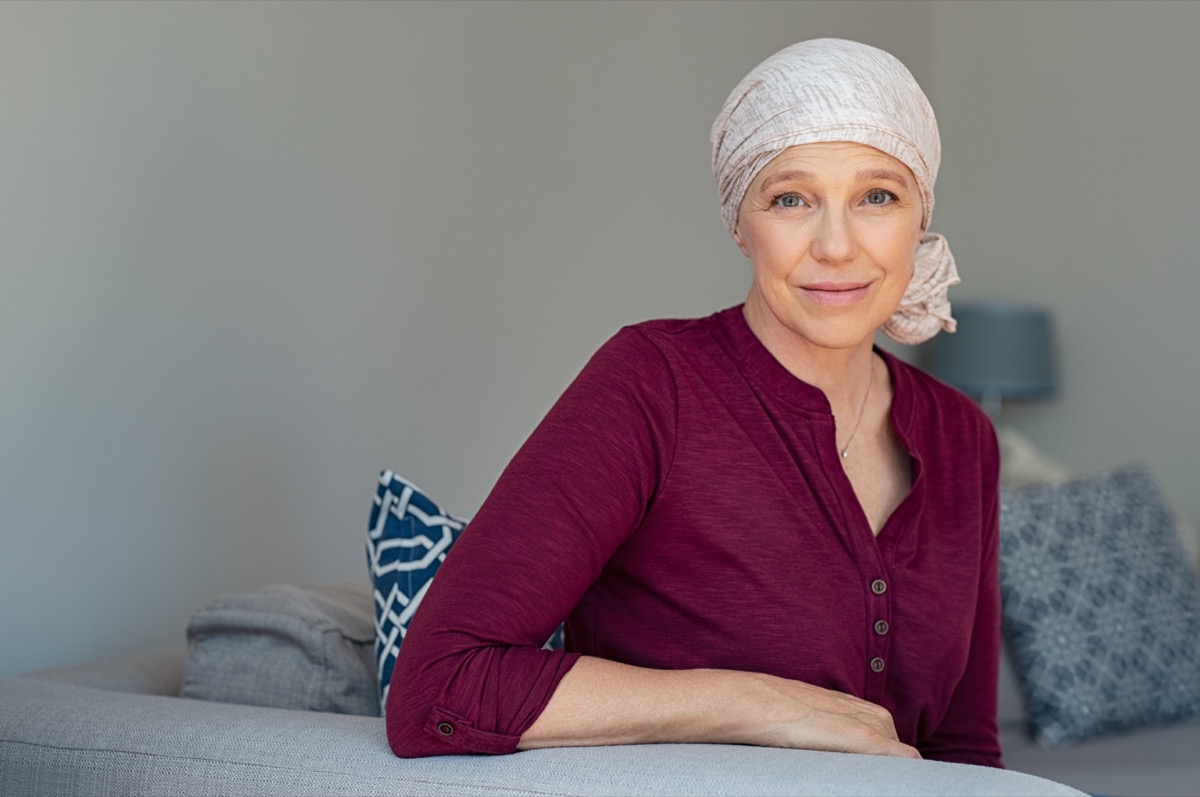Although cancer has become more treatable today due to early detection through screenings and advances in medicine and technology, it's not a diagnosis you ever want to hear. While there's many types of cancer that are beatable, it's still the second leading cause of death in the United States. The American Cancer Society says, "Cancer continues to be the second most common cause of death in the US, after heart disease. A total of 1.9 million new cancer cases and 609,360 deaths from cancer are expected to occur in the US in 2022, which is about 1,670 deaths a day." And according to the National Cancer Institute, "Breast, lung and bronchus, prostate, and colorectal cancers account for almost 50% of all new cancer cases in the United States. Lung and bronchus, colorectal, pancreatic, and breast cancers are responsible for nearly 50% of all deaths."
Breast cancer is one of the most feared health concerns for women and the Centers for Disease Control and Prevention states, "Different people have different symptoms of breast cancer. Some people do not have any signs or symptoms at all. Some warning signs of breast cancer are: New lump in the breast or underarm (armpit), thickening or swelling of part of the breast, irritation or dimpling of breast skin, redness or flaky skin in the nipple area or the breast, pulling in of the nipple or pain in the nipple area, nipple discharge other than breast milk, including blood, any change in the size or the shape of the breast, pain in any area of the breast."
Lung Cancer is a leading cause of death and the American Cancer Society estimates there will be "About 130,180 deaths from lung cancer–68,820 in men and 61,360 in women for 2022. The Mayo Clinic states, "Lung cancer typically doesn't cause signs and symptoms in its earliest stages. Signs and symptoms of lung cancer typically occur when the disease is advanced.
Signs and symptoms of lung cancer may include: A new cough that doesn't go away, coughing up blood, even a small amount, shortness of breath, chest pain, hoarseness, losing weight without trying, bone pain, headache."
Colorectal cancer happens when, "abnormal growths in the colon or rectum that can turn into cancer if not removed and colorectal cancer don't always cause symptoms, especially at first," the CDC says. "Someone could have polyps or colorectal cancer and not know it. That is why getting screened regularly for colorectal cancer is so important. If you have symptoms, they may include: A change in bowel habits, blood in or on your stool (bowel movement), diarrhea, constipation, or feeling that the bowel does not empty all the way. abdominal pain, aches, or cramps that don't go away, weight loss and you don't know why."
Pancreatic cancer is one of the most terrifying types of cancer because there's oftentimes no signs and it's one of the deadliest. "Pancreatic cancer (PC) is one of the most aggressive tumors with less than 5% survival at 5 years," wrote the authors of a study in the World Journal of Gastrointestinal Oncology. "Beside its poor prognosis and its late diagnosis, pancreatic cancer remains one of the most painful malignancies," the author added. The Mayo Clinic states, "Pancreatic cancer is seldom detected at its early stages when its most curable. This is because it often doesn't cause symptoms until after it has spread to other organs." Signs of the cancer often don't appear until a late stage and symptoms could include, "Abdominal pain that radiates to your back, loss of appetite or unintended weight loss, yellowing of your skin and the whites of your eyes (jaundice), light-colored stools, dark-colored urine, itchy skin, new diagnosis of diabetes or existing diabetes that's becoming more difficult to control, blood clots, fatigue," the Mayo Clinic says.
Eat This, Not That! Health spoke with Dr. Tomi Mitchell, a Board-Certified Family Physician with Holistic Wellness Strategies who shares what to be aware of with cancer and signs to watch out for. Read on—and to ensure your health and the health of others, don't miss these Sure Signs You've Already Had COVID.
Dr. Mitchell says, "Cancer is a diagnosis that most people don't want to experience, but it is an unfortunate reality. If one gets a cancer diagnosis, the hope is that it is found very early in an operable area and a type of cancer that responds exceptionally well to treatment with little chance of reoccurrence. Early detection is critical in increasing the odds of successful treatment and survival. While some types of cancer can be cured, others can only be controlled for a time. The best thing anyone can do for themselves is to learn about the warning signs of cancer and to see their doctor regularly for screenings. Cancer treatments have come a long way in recent years, but there is still much progress. With continued research and advances in medicine, it is hoped that one day, cancer will be nothing more than a bad memory.
Sometimes in practice, I have to let my patients know that they should "prepare for the worst and hope for the best." This statement doesn't mean that we have given up. Instead, we have done a thorough investigation, and we 'leave no stone untouched.' As much as possible, we want to have a clear picture of the spread of the disease, and we start the investigations, alongside discussion of treatment options, immediately."

Dr. Mitchell explains, "When a person is diagnosed with cancer, they and their doctor will work together to develop a treatment plan. This plan may involve surgery, radiation therapy, and/or chemotherapy. The goal of treatment is to remove the cancerous cells from the body or to destroy them so they can no longer grow or spread. However, in some cases, cancer may be located in an area that makes it impossible to remove surgically or it may have spread extensively throughout the body. When this occurs, the cancer is considered inoperable. While there are still some treatment options available for inoperable cancer, the prognosis is often very poor. Inoperable cancer is difficult to treat effectively and as a result, the majority of people with this diagnosis do not have great long-term survival rates.
When the cancer is inoperable, the focus of treatment might shift from cancer eradication to symptom control and doing everything possible to maintain a good quality of life. While there is no cure for inoperable cancer, patients can still receive treatments that help to improve their symptoms and manage their pain. With the help of a supportive team of healthcare professionals, patients can still live fulfilling lives despite their diagnosis."

"When you have exhausted all your treatment options for cancer, it means that cancer has progressed to a point where conventional therapies are no longer effective," Dr. Mitchell explains. "This is a very bad sign because it means that the cancer is likely to continue growing and spreading, potentially leading to death. While there are some experimental treatments that may be effective in some cases, the chances of success are usually very low when all other options have failed. This is why it is so important to catch cancer early and start treatment as soon as possible. Early detection and treatment give you the best chance of beating the disease.
When all conventional treatment options have been exhausted, some patients turn to non-conventional treatments as a last effort. While these treatments are not always safe or covered by insurance, they can be effective when conventional treatments have failed. This can be a challenging decision for patients and their families, as they must weigh the risks and benefits of these treatments. In some cases, patients may need to make tough choices about how to spend their limited resources. However, non-conventional treatments can offer hope when all other options have been exhausted."

Dr. Mitchell tells us, "When cancer cells begin to proliferate in the body, they can start to crowd out healthy cells and disrupt normal cell function. This can lead to a wide range of symptoms, including weight loss, fatigue, and weakness. In some cases, patients may be able to maintain their weight and strength despite the presence of cancer cells. However, if cancer begins to spread throughout the body and starts to interfere with vital organ function, it can lead to a sudden and drastic decline in health.
This is often a sign that the cancer is progressing rapidly and is starting to take over the body. While there are sometimes treatments available that can slow down the spread of cancer, once the disease reaches this stage, it is generally considered to be terminal. As such, a sudden decline in health is usually bad news for patients with cancer."

"Stage four cancer, also known as metastatic cancer, is a serious and advanced form of the disease," Dr. Mitchell says. "In stage four, cancer has spread from its original site to other parts of the body. This can make treatment difficult, as the cancer is no longer confined to one area. Metastatic cancer is often harder to treat successfully than early-stage cancer, as the cancer cells have already spread and are difficult to eradicate.
There are a few reasons why a late-stage cancer diagnosis can be more serious. First, cancers that are detected early tend to be smaller and therefore easier to treat. Additionally, early detection allows doctors to begin treatment before cancer has had a chance to spread to other parts of the body. Finally, cancers that are caught in their early stages tend to respond better to treatment than those that are not. While there are exceptions to every rule, late-stage cancer diagnoses are generally more serious and cause for greater concern than those made in the disease's earlier stages."
The post Sure Signs You Have the "Most Feared" Cancer appeared first on Eat This Not That.
----------------
By: Heather Newgen
Title: Sure Signs You Have the "Most Feared" Cancer
Sourced From: www.eatthis.com/sure-signs-you-have-the-most-feared-cancer/
Published Date: Sun, 23 Oct 2022 11:15:58 +0000
Read More
Did you miss our previous article...
https://naturesmart.us/fitness/12-oldfashioned-airline-foods-we-want-back-asap
 HealthWellnessFitnessBeautyVideosPrivacy PolicyTerms And Conditions
HealthWellnessFitnessBeautyVideosPrivacy PolicyTerms And Conditions
